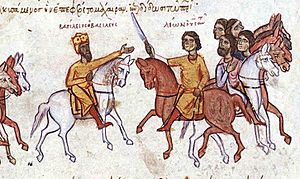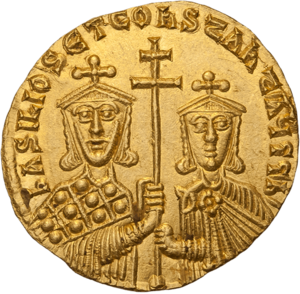Basil I facts for kids
Quick facts for kids Basil I |
|
|---|---|
| Emperor of the Romans | |
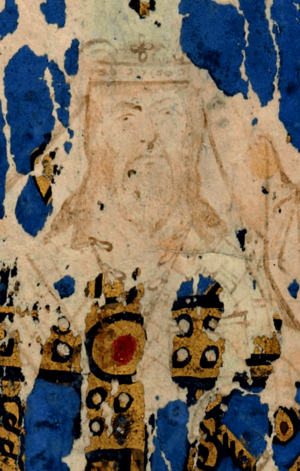
Underdrawing of Basil I in the Paris Gregory, c. 879–883
|
|
| Byzantine emperor | |
| Reign | 24 September 867 – 29 August 886 |
| Coronation | 26 May 866 (as co-emperor) |
| Predecessor | Michael III |
| Successor | Leo VI |
| Co-emperor | Constantine (868–879) |
| Born | late 811 Chariopolis, Macedonia, Byzantine Empire (now Hayrabolu, Tekirdağ, Turkey) |
| Died | 29 August 886 (aged 75) |
| Consort | Eudokia Ingerina |
| Wives |
|
| Issue Detail |
Constantine Emperor Leo VI (paternity uncertain) Emperor Alexander Patriarch Stephen I (paternity uncertain) |
| Dynasty | Macedonian dynasty |
Basil I, also known as "the Macedonian" (Greek: Βασίλειος ὁ Μακεδών, translit. Basíleios ō Makedṓn), was a Byzantine emperor who ruled from 867 to 886. He was born in 811 and came from a simple peasant family in the region of Macedonia.
Basil rose through the ranks at the imperial court. He started by working for a relative of Emperor Michael III (who ruled from 842–867). A rich woman named Danielis helped him, and he also gained the favor of Emperor Michael III. Michael made him his bodyguard and later, his co-emperor. In 867, Basil became the sole ruler of the Byzantine Empire. Even though he came from humble beginnings, he was a very skilled leader. He founded the Macedonian dynasty, a powerful family that ruled the empire for a long time. After his death, his son Leo VI became emperor.
Contents
Becoming Emperor
Basil was born in late 811 in a place called Chariopolis. This was in the Byzantine region of Macedonia, which is now part of Turkey. His father's name was Bardas, and his mother was Pankalo. Historians believe his father might have been from Armenia.
Later, during Basil's rule, stories were told that his family was actually related to famous people like the kings of Armenia, Alexander the Great, and even Constantine the Great. This was likely done to make his rule seem more important and legitimate.

One story says that Basil spent part of his childhood as a captive in Bulgaria. His family was supposedly taken there by the Bulgarian ruler Khan Krum in 813. Basil lived in Bulgaria until 836, when he managed to escape back to Byzantine lands.
After escaping, Basil was lucky enough to find work with Theophilitzes, a relative of Emperor Michael III's uncle, Bardas. Basil started as a groom, taking care of horses. While working, he visited the city of Patras. There, a wealthy woman named Danielis was impressed by him. She took him into her home and gave him a lot of money.
Basil also caught the attention of Emperor Michael III. He was very good at taming horses. He also won a wrestling match against a strong Bulgarian champion. Because of his skills, he quickly became a close friend and bodyguard to the Emperor. People described Basil as a strong man with a serious look.
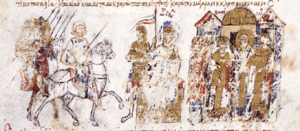
Around 865, Emperor Michael asked Basil to marry Eudokia Ingerina. Basil divorced his first wife, Maria, to do so. In 866, Basil convinced Michael III that his uncle Bardas wanted to take the throne. With Michael's approval, Basil arranged for Bardas to be removed. After this, Basil became a very important person at court. He was given the high title of kaisar (Caesar). Soon after, on May 26, 866, he was crowned co-emperor alongside Michael III.
It was widely believed that Basil's son, Leo VI, was actually Michael III's son. Even Basil seemed to believe this and didn't always get along with Leo. However, Basil's new position as co-emperor helped make Leo's claim to the throne legitimate. When Leo was born, Michael III celebrated with public chariot races. He made sure Basil knew that Leo's birth was important for the empire.
Later, Michael III started to favor another courtier named Basiliskianos. Basil felt his own position was in danger. Michael even threatened to make Basiliskianos an emperor. To prevent this, Basil arranged for Michael III to be removed from power on September 24, 867. Since Basil was already a co-emperor, he automatically became the sole ruler of the Byzantine Empire.
Basil's Rule
| Basil I the Macedonian, Emperor of the Romans | |
|---|---|
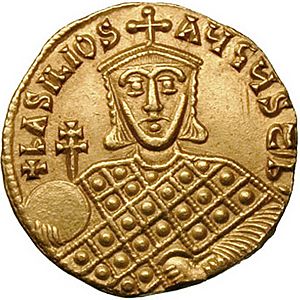
Gold solidus of Basil I
|
|
| Emperor | |
| Venerated in | Eastern Orthodoxy |
| Major shrine | Church of the Holy Apostles, Constantinople modern day Istanbul, Turkey |
| Feast | 29 August |
| Attributes | Imperial Vestment |
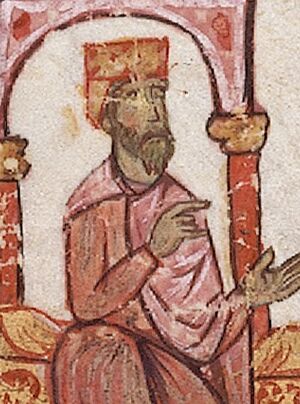
Even though Basil I had no formal education and little experience in military or government, he became a very effective and respected emperor. People in Constantinople didn't like Michael III much because he wasn't interested in his duties. Michael's public actions also made many people unhappy. So, when Basil took power, there wasn't much opposition.
Once in charge, Basil quickly showed he intended to rule well. From his coronation, he showed strong religious devotion. He maintained a reputation for being a good and religious leader throughout his 19-year reign.
Laws and Buildings
Basil I is often called the "second Justinian" because of all the new laws he created. Basil's laws were gathered into a large collection called the Basilika. This collection had sixty books. He also created smaller law books like the Eisagoge. His son, Leo VI, helped finish these legal works. The Basilika remained the law of the Byzantine Empire until it was conquered by the Ottomans.
Basil also personally supervised the building of the Nea Ekklesia cathedral. He also oversaw the construction of his palace hall, the Kainourgion. In terms of religion, he had good relationships with Rome. One of his first actions was to remove the Patriarch of Constantinople, Photios. He then brought back Ignatios, who was supported by Pope Adrian II.
Foreign Affairs
During Emperor Basil's reign, the empire was fighting a difficult war against a group called the Paulicians. They were based in Tephrike and often raided Byzantine lands. Basil's general, Christopher, defeated the Paulicians in 872. Their leader, Chrysocheir, died, which led to the end of their state.
Basil was the first Byzantine emperor since Constans II (who ruled from 641–668) to actively try to make the empire strong again in the West. Basil made an alliance with Holy Roman Emperor Louis II (who ruled from 850–875) to fight against the Arabs. He sent a fleet of 139 ships to clear the Adriatic Sea of Arab raids.
With help from the Byzantines, Louis II captured Bari from the Arabs in 871. This city later became Byzantine territory in 876. However, the Byzantine situation on Sicily got worse. The city of Syracuse fell to the Emirate of Sicily in 878. This happened partly because Basil had redirected a fleet meant for Sicily to transport marble for a church instead.
Even though most of Sicily was lost, a general named Nikephoros Phokas managed to take Taranto and much of Calabria in 880. These victories in the Italian peninsula marked a new period of Byzantine power there. Most importantly, the Byzantines started to have a strong presence in the Mediterranean Sea, especially the Adriatic.
Final Years and Successor
Basil's mood became sad in 879 when his oldest and favorite son, Constantine, passed away. After this, Basil made his youngest son, Alexander, a co-emperor. Basil did not like his other son, Leo, who loved books. Basil sometimes even hit Leo. He probably suspected that Leo was actually the son of Michael III.
In his later years, Basil's relationship with Leo was difficult. Basil worried that Leo might want to get revenge for Michael III's removal. Leo was eventually put in prison by Basil after a suspected plot was found. But this imprisonment caused public unrest. Basil threatened to blind Leo, but Patriarch Photios convinced him not to. Leo was finally released after three years.
Basil died on August 29, 886. He got a fever after a serious hunting accident. His belt got caught in a deer's antlers, and he was dragged a long way through the woods. An attendant saved him by cutting him loose with a knife. However, Basil suspected the attendant of trying to harm him and had the man removed shortly before he died.
One of the first things Leo VI did as the new emperor was to rebury Michael III's remains with a grand ceremony. He placed them in the Imperial Mausoleum in the Church of the Holy Apostles in Constantinople. This action made many people believe that Leo considered himself Michael's son.
Family
Historians are still learning about Basil I's family life. Some details are not completely clear because there are not many records from that time.
Here is some information about his children:
- With his first wife, Maria, Basil I had several children, including:
- Bardas.
- Anastasia, who married a general named Christopher.
- Constantine (born around 860 – died September 3, 879). He was crowned emperor in January 868.
- With Eudokia Ingerina, Basil I had the following children:
- Leo VI, who became the Byzantine emperor. Some believed he was actually a son of Michael III.
- Stephen I, who became the Patriarch of Constantinople. Some also believed he was a son of Michael III.
- Alexander, who became the Byzantine emperor in 912.
- Anna Porphyrogenita, who became a nun.
- Helena Porphyrogenita, who became a nun.
- Maria Porphyrogenita, who became a mother of nuns.
Leo VI's son, Constantine VII, wrote a book about his grandfather, Basil I, called the Vita Basilii, around the year 950.
See also
 In Spanish: Basilio I para niños
In Spanish: Basilio I para niños
Secondary sources
- "Vita Basilii". The Oxford Dictionary of Byzantium. (1991). Oxford and New York: Oxford University Press. 2180-2181.
- "Prosopographie der mittelbyzantinischen Zeit".. (2013). De Gruyter.


